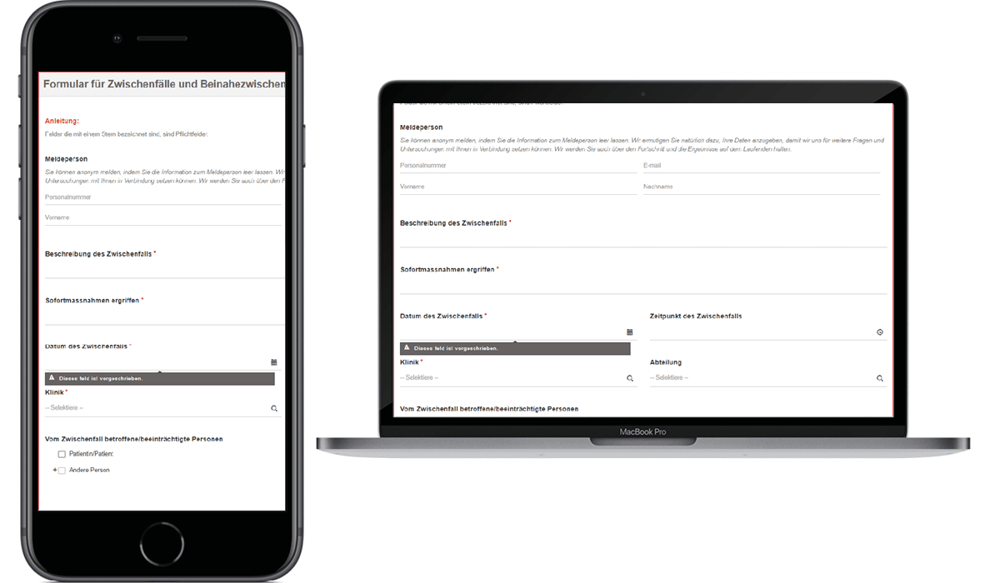Incident reports help caregivers and their managers identify the factors contributing to healthcare incidents. However, collecting incident data is just the first step in the incident management process. To improve safety for patients and staff, the right people must be able to access, sort, organize, and analyze the incident data. To ensure such access, security, and transparency, healthcare organizations are increasingly employing digital incident reporting software. The tools within these SaaS-based systems not only make it easier to register the relevant data, but also facilitate sharing it across the organization.
In addition, your organization can use specific software applications to register data for different types of healthcare incidents. Each reporting application enables you to use workflows that fit the internal process for handling these types of incidents:
Application overview for 5 different types of healthcare incidents:
- Patient-related incidents
- Staff-related incidents (OHS)
- Complaints by patients or family
- Aggression incidents
- Information security incidents
Patient-related incidents
Prompt (near) incident reporting is important so that everyone involved is aware of the event’s occurrence and still retains the surrounding details. However, sometimes a report contains limited information. To analyze the incident well, it's helpful to be able to easily check with the patient and family.
The following are recommendations for reporting patient-related incidents:
- In (near) fatal situations, start the follow-up process immediately. Of course, it’s recommended to focus on the patient first to prevent the incident from happening again. Build-in this shortcut process into the workflow.
- Document all the relevant information on time and collect the views of all people involved (patient, family, and staff) to help your legal department too. Unfortunately, lawsuits are common in healthcare, so an early, comprehensive collection of all details of a situation is essential.
Read more about our healthcare incident management application.
Staff-related incidents (OHS)
Incidents, errors, and events occur for various reasons, and poor training, digression from protocols, and miscommunication are just a few of them. Unfortunately, incidents happen not only to patients, but to staff as well. For example, needle sticks, cuts, and splashing incidents are common. Getting proper insights into what went wrong can lead to improved training or credentialing standards.
Recommendations for reporting staff-related incidents:
- Promote a Just Culture in your department, wherein staff feels free to report incidents. Sometimes healthcare workers feel guilty or unsure about reporting incidents. Management must work on a culture where safety is important and incident reporting can be done without personal punishment.
- Implement a process for peer support: On some occasions staff can suffer anxiety, burnout, or even symptoms of post-traumatic stress syndrome due to an incident in which they were involved. The best help you can provide will come from someone who understands the situation: a colleague. Some 85% of these so-called second victims, however, do not ask for help themselves. It is therefore important that supervisors proactively offer after-care for incidents.
Read more about our OHS application.
Complaints by patients or family
A near-incident, miscommunication, or even just a different point of view can lead to a complaint by a patient or their family. Managing complaints is essential but takes valuable time from already-overloaded employees and exposes hospitals and healthcare organizations to legal or reputational risk. Digital reporting and central collection of complaints will help the organization mitigate those risks.
Recommendations for reporting patient feedback:
- Complaints and incident reports can have the same cause or even tie back to the same situation. Therefore, it's important to use software that brings together both incidents and complaints and connects them to ensure all relevant information is available for the follow-up process. Nursing officers and complaints managers can collaborate, work efficiently in managing the event/complaint, and collectively improve the care process—the ultimate goal.
- Fortunately, people mainly have good experiences with care and are eager to express this satisfaction. Ensure you offer patients and their families an avenue for positive feedback, for example, by creating a form on your website. Because feedback can be both positive and negative, this data should be collected in the same application.
Read more about our feedback application.
Aggression incidents
What we hear from nurses is that incidents involving aggressive patients or families have a lot of impact, causing unrest and negativity in the workplace. Violence not only comes as pushing or hitting a healthcare worker but can also be verbal. Security is often called in, but sometimes it can be just too late.
Recommendations for reporting violent events:
- The earlier-mentioned peer support is also important in cases of aggressive behavior towards employees. A quick follow-up by direct management and HR is important to support your staff. This will directly impact staff satisfaction too.
- To be able to quickly follow up on a violence or verbal abuse incident, it's important that such an incident is reported immediately. Give staff the tools within a digital system that also enables reporting on mobile devices. The result will be an easy and smooth process that encourages reporting.
Read more about our aggression incidents application.
Information security incidents
Incidents also occur with data. Healthcare data is among the most confidential information—which unfortunately makes it valuable to thieves. Events where patient data is openly accessible in the workplace or when hackers get access to healthcare IT systems can lead to huge legal and reputational risks. The follow-up process for reporting and analyzing information security incidents is different from patient- or staff-related incidents, and compliance regulations around data security are very strict. As a result, we recommend using a separate application for reporting such incidents.
Recommendations for reporting information security incidents:
- When a data leak is discovered, immediately and directly involve your legal department and compliance officer.
- Start with open and transparent communication to all the people involved. Depending on the scale of the event, it is advisable to involve your board and PR agency too.
Read more about our information security incidents application.
TPSC Cloud software
Are incidents still reported on paper in your organization? Is deciphering handwriting part of your daily job? Stop using paper forms and experience the convenience of a digital platform for risk management!
Are incidents still collected in Excel spreadsheets? How do you ensure data doesn't get lost and is easily accessible by management throughout the organization? Start using professional cloud software, specifically build for healthcare organizations.
Get your free online demo from our sales consultant. Together you will dive into your specific questions and see how you can adapt our software very easily.

%20(3)%20(1).jpg)


